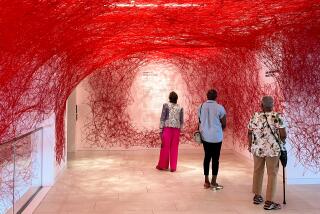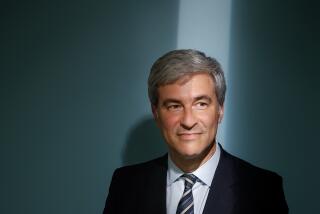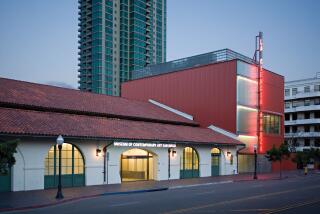IMPACT OF ALL ADMINISTRATION CUTS WORRIES ARTS OFFICIALS : Top Museum Fund-Raisers Are Finding That Individual and Corporate Donors Are Shifting Their Priorities.
The subject was budget crunches.
Taking time out from gazing at the permanent collections and making their way through the new construction at the County Museum of Art on Monday night, eight museum development (fund-raising) officials from across the country talked economics.
Squeezed around a small table in the museum atrium while a Mexican buffet and a cellist warmed up in the background, the officials compared the return on their endowment investments and despaired over Reagonomics.
It wasnât so much the proposed federal cutbacks to the arts that worried them but the impact of Reagan Administration cutbacks across the board--as well as the state of the nationâs economy.
As the Administration tightens the belt on social service programs to the sick, the elderly and the homeless, top museum fund-raisers have been finding that individual and corporate donors have been shifting priorities.
James Kraft, assistant director of New Yorkâs Whitney Museum of Art, who led the discussion, put it bluntly:
âOperational costs of all museums go up and weâre all suffering to some degree. The cutbacks (thus far) from the national Administration in terms of the arts have really not been that severe.
âI think the problem has been that the cutbacks in all kinds of educational, health and social services have been severe,â he continued, âso that the resulting pressure being put on individuals, foundations and corporations means that there just isnât as much money to go around.â
Rick Larkin, development director at the Mystic Seaport Museum in Mystic, Conn., noted that recently he went to Hartford to try to raise money from âthe big insurance companies in the insurance capital of the world.â He found â40 capital campaigns going on all at once seeking to raise $201 million for hospitals, churches and for state and local educational institutions. Aetna recently gave $1.3 million to the University of Connecticut.â
While arts representatives attempt to argue âquality of lifeâ issues with potential givers, they realize that often their cause gets relegated to the back burner.
On the front burner, meanwhile, the museum officials today wind up a three-day American Museum Development Assn. conference at the Beverly Wilshire. In private sessions, they have shared ideas on such matters as âHow to Survey and Analyze Your Constituency to Support Future Solicitationsâ and âHiring a Consultant--If, When and How to Get Rid of One in Permanent Residence.â
Margaret Skidmore, development director of the Museum of Fine Arts in Houston, pointed out that the general crunch among oil companies has affected all organizations in the arts and elsewhere.
âEspecially the oil companies and the banks are doing much less than they have in the past,â Skidmore said. âWeâre now being turned down for $50,000 grants that Iâm sure we would have gotten if we didnât have the crunch. Our budget from last year to this year has been almost a no-growth budget. Weâre just having to be more creative.â
Lori Yorish, development director at the Denver Museum of Art, also cited loss from oil money and other corporate money in her region. Yorish, who had been less vocal than her colleagues through much of the hourlong discussion, said that her museum would have to âscale back.â
Asked how much or what that would mean to the museum whose budget is currently $4.6 million, Yorish replied: âIâd rather not say.â
Kerry Buckley, development director of Los Angelesâ Museum of Contemporary Art, whose budget has gone from $1 million to the current $4.6 million to a projected $7 million for the new fiscal year beginning July 1, cited corporate mergers as another factor in the shrinking corporate pool. âAs a result, weâve (the museum community) lost Gulf, Getty, and Wells Fargo bought Crocker.â
Buckley reported that despite MOCAâs expansion--the main building opens in December in California Plaza downtown--consideration is being given to trimming costs by having exhibitions last longer. The museum development officials have toured the new facility as well as its Temporary Contemporary.
Even at the Art Institute of Chicago, whose $36-million-a-year budget is second only to the New Yorkâs Metropolitan Museum of Art, there is talk of scaling back.
Christine OâNeill, the instituteâs assistant vice president for development, said that even though a new wing for American and European decorative art, scheduled to open in 1988, is running about $5 million more than the original $20-million projection, âwe have just gotten wordâ that it will still have to come in on budget. OâNeill said she didnât know how that would be done.
Museums are now considering using television--and hosting parties at their museums--to bring in additional monies. Kraft noted that âof all the arts organizations, museums have been the most reluctantâ to go on TV. âWe donât rely on ticket sales to bring people in.â And art, he added, doesnât appear to play as well on television.
âWhen they put âNicholas Nicklebyâ on television, more people read the book than in the history of the novel,â Kraft said.
Meanwhile, several museums have begun charging use of their facilities for party-givers. Houston began doing it in 1982, Skidmore said, at $6,000 a party. MOCA, chimed in Buckley, charges $10,000.
Margaret Moore, director of development and public relations at the Chrysler Museum in Norfolk, Va., would like to take a more prosaic route. Because of tight state and local budgets--75% of the museumâs $2.2-million budget comes from state and local funds--Moore would like to put on a simple membership drive. âBut we havenât got room for that in our budget. Weâre between a rock and a hard place,â she said.
Despite their focus on more immediate issues, the museum representatives are still keeping an eye on the budget process in Washington. Theyâre particularly concerned about the fate of the Institute for Museum Services which provides operational, or as Houstonâs Skidmore noted, ânon-glitzyâ aid for basic costs. Several noted that even with a maximum grant of $75,000--if that money comes in every year or even every other year--the support from Museum Services is considerable.
As Kraft noted, the Whitney gets about $150,000 from the New York State Council on the Arts, âbut we have gotten that every year.â
And Kraft pointed out, as have so many arts officials in public testimony before Congress and elsewhere, that even though federal support might account for as little as 2% of an institutionâs budget, a grant from the National Endowment for the Arts means âthe stamp of approval, the Good Housekeeping Seal of Approval, if you will,â of a museumâs worth. Without that, Kraft noted, private donations are harder to come by.
Concern about the federal situation, noted Buckley, âdoesnât allow us to dream as much as we want to dream.â
Meanwhile, corporations and foundations are seeking, as James Forbes, deputy director of development at the Fine Arts Museums of San Francisco, expressed it, âthe biggest bang for their dollar. The first thing they want is as much publicity as they can get.â
Several noted that corporations seem less inclined to give directly to exhibitions, but that they would fund a program to bus children to the museum to see the exhibition.
As counterpoint to the choices the Reagan Administration makes in funding, museum officials indicated, the private sector seems to be taking a more liberal--or concern for the underdog--approach in its allocations.
At the same time, Forbes lamented that the corporate base in San Francisco is shrinking. âTheyâre all moving to L.A.,â he said.
More to Read
The biggest entertainment stories
Get our big stories about Hollywood, film, television, music, arts, culture and more right in your inbox as soon as they publish.
You may occasionally receive promotional content from the Los Angeles Times.










